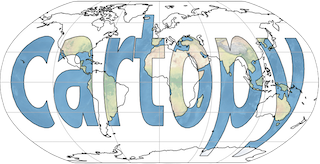备注
Go to the end 下载完整的示例代码。
利用正极投影绘制NOAA的极光预报#
美国国家海洋和大气管理局(NOAA)使用靠近日地系统L1拉格朗日点运行的ACE航天器监测太阳风状况。这些数据被输入OvATION-Prime模型,以预测地球上不同位置可见极光的可能性。每五分钟就会发布未来30分钟的新预报。该数据以可见极光百分比的360 x 181概率网格形式提供。数据以0到359和-90到90等度间隔。

from datetime import datetime
import json
from urllib.request import urlopen
from matplotlib.colors import LinearSegmentedColormap
import matplotlib.pyplot as plt
import numpy as np
import cartopy.crs as ccrs
from cartopy.feature.nightshade import Nightshade
def aurora_forecast():
"""
Get the latest Aurora Forecast from https://www.swpc.noaa.gov.
Returns
-------
img : numpy array
The pixels of the image in a numpy array.
img_proj : cartopy CRS
The rectangular coordinate system of the image.
img_extent : tuple of floats
The extent of the image ``(x0, y0, x1, y1)`` referenced in
the ``img_proj`` coordinate system.
origin : str
The origin of the image to be passed through to matplotlib's imshow.
dt : datetime
Time of forecast validity.
"""
# GitHub gist to download the example data from
url = ('https://gist.githubusercontent.com/lgolston/594c030876c0614d3'
'6d13d03e4f115b6/raw/342ff751419204594180e88d69b3986dbd4fea4a/'
'ovation_aurora_latest.json')
# To plot the current forecast instead, uncomment the following line
# url = 'https://services.swpc.noaa.gov/json/ovation_aurora_latest.json'
# load data (JSON format)
response = urlopen(url)
aurora = json.loads(response.read().decode('utf-8'))
# parse timestamp
dt = datetime.strptime(aurora['Forecast Time'], '%Y-%m-%dT%H:%M:%SZ')
# convert lists of [lon, lat, value] to 2D array of probability values
aurora_data = np.array(aurora['coordinates'])
img = np.reshape(aurora_data[:, 2], (181, 360), order='F')
img_proj = ccrs.PlateCarree()
img_extent = (0, 359, -90, 90)
return img, img_proj, img_extent, 'lower', dt
def aurora_cmap():
"""Return a colormap with aurora like colors"""
stops = {'red': [(0.00, 0.1725, 0.1725),
(0.50, 0.1725, 0.1725),
(1.00, 0.8353, 0.8353)],
'green': [(0.00, 0.9294, 0.9294),
(0.50, 0.9294, 0.9294),
(1.00, 0.8235, 0.8235)],
'blue': [(0.00, 0.3843, 0.3843),
(0.50, 0.3843, 0.3843),
(1.00, 0.6549, 0.6549)],
'alpha': [(0.00, 0.0, 0.0),
(0.50, 1.0, 1.0),
(1.00, 1.0, 1.0)]}
return LinearSegmentedColormap('aurora', stops)
def main():
fig = plt.figure(figsize=[10, 5])
# We choose to plot in an Orthographic projection as it looks natural
# and the distortion is relatively small around the poles where
# the aurora is most likely.
# ax1 for Northern Hemisphere
ax1 = fig.add_subplot(1, 2, 1, projection=ccrs.Orthographic(0, 90))
# ax2 for Southern Hemisphere
ax2 = fig.add_subplot(1, 2, 2, projection=ccrs.Orthographic(180, -90))
img, crs, extent, origin, dt = aurora_forecast()
for ax in [ax1, ax2]:
ax.coastlines(zorder=3)
ax.stock_img()
ax.gridlines()
ax.add_feature(Nightshade(dt))
ax.imshow(img, vmin=0, vmax=100, transform=crs,
extent=extent, origin=origin, zorder=2,
cmap=aurora_cmap())
plt.show()
if __name__ == '__main__':
main()
Total running time of the script: (0分4.372秒)
Gallery generated by Sphinx-Gallery _
